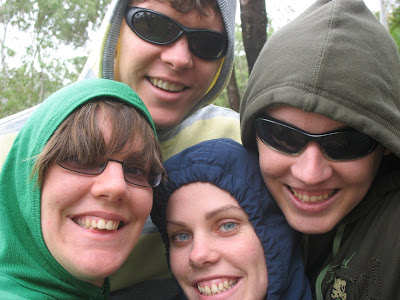I made a spontaneous (thanks to Hilton and Justina) visit to Brisbane over the weekend to sort out wedding plans with parents and other parties… We now have a confirmed menu for our reception, an idea of exactly how many people will fit into the venue (120) and an idea of how the ceremony and morning tea/brunch/whatever will run.
Robyn’s main reason for making the trip to the “big city” was to search for bridesmaid dresses. Her search took her far and wide – they (Robyn and her sisters) travelled the length and breadth of South East Queensland looking for suitable dresses – spending many fruitless days digging through bridal specialists, looking at plans and checking all the appropriate boxes (literally and figuratively). They found nothing.
I had some time free on Saturday afternoon when I arrived. So I went suit shopping with mum and Mattias. We found appropriate suits in the second shop we went to. We bought them. I am sorted. I chose a very dark chocolate brown suit with brown pin stripes. It’s spiffy. I’m so glad I’m a guy.
In other news…
In today’s Courier Mail there was a brief (a one paragraph story for those not familiar with the media vernacular) on the explosion (figuratively not literally) of pest fish populations in the riverways of South East Queensland. The story calmly advised that drastic measures would be taken and that these pest fish (carp, tilapia etc) would be rounded up and electrofished. What on earth is electrofishing? That was my response too – I looked it up so you don’t have to…
This is a definition from Wikipedia’s fishing entry:
“A relatively new fishing technique is electrofishing, typically used for stream classification surveys and catching brood stock for hatcheries, or making estimates of populations in a body of water. A gated pulse of direct current is used to cause muscular contractions in a fish, called galvanotaxis, causing them to turn towards the source of the electrical current and swim towards it when correct pulse speeds and durations are used, along with correct current.”
For those intrigued by the concept here’s the how to guide from http://www.electro-fisher.com/… they’ve also got videos of electrofishing in action. Complete with really cheesy soundtrack.
http://www.electro-fisher.com/How_to_electrofishing.html
But remember…
“Fishermen should also remember that electrofisher is an electric device in order to avoid the contact of electric field with the bare body- waders must be waterproof and be electrically resistant as well as landing net must be plastic not to paralyse anybody – the same refers to boats. The electrofisher SAMUS700 is very safe but it is not reccomended to put the hands into water while electro fishing though”









